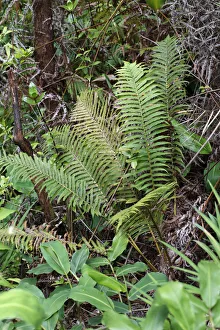Lycopodiaceae Collection
"Lycopodiaceae: A Fascinating Family of Club Mosses" The Lycopodiaceae family, also known as club mosses
All Professionally Made to Order for Quick Shipping
"Lycopodiaceae: A Fascinating Family of Club Mosses" The Lycopodiaceae family, also known as club mosses, encompasses a diverse range of species that captivate with their unique characteristics and habitats. One such member is the Alpine Clubmoss (Lycopodium alpinum), or Diphasiastrum alpinum, which displays its vibrant colors in a captivating colour litho. Another notable species within this family is the Wawaeʻiole (Huperzia nutans), an endemic club moss found exclusively on the Big Island of Hawaii, USA. Its presence highlights the remarkable biodiversity present in this tropical paradise. Moving across continents to Emsland, Lower Saxony, Germany, we encounter the Bog Clubmoss (Lycopodiella inundata) and Round-leafed Sundew (Drosera rotundifolia) coexisting harmoniously. This picturesque scene showcases nature's ability to create beautiful symbiotic relationships. In Studland, Dorset, England during August, Marsh Clubmoss (Lycopodiella inundata) thrives on wet peat with its fertile fronds proudly displayed. These resilient plants demonstrate their adaptability to challenging environments while adding beauty to their surroundings. Venturing into Adirondack Mountains in New York State during October reveals Blue Ground-cedar (Lycopodium tristachyum). This woodland dweller adds an enchanting touch to its habitat with its delicate foliage and graceful presence. Lastly but not leastly we have Lycopodium magellanicum - another stunning club moss that contributes to the allure of our natural world. With each species exhibiting distinct features and adaptations for survival, it becomes evident why lycophytes are considered living fossils due to their ancient lineage dating back millions of years. From lush Hawaiian rainforests to German bogs and English marshlands.








